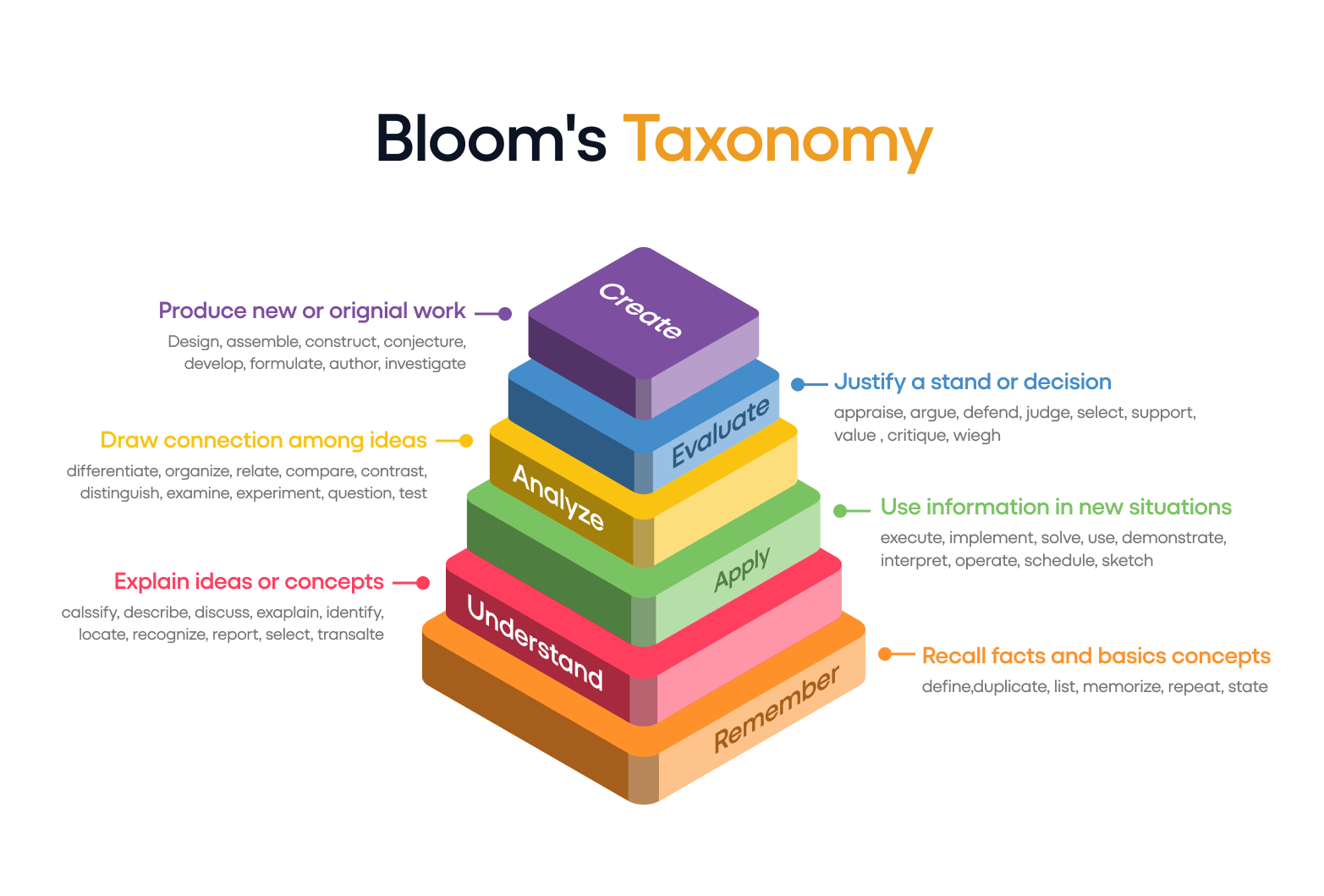The hierarchy of learning – Applying the most effective study techniques

Introduction
In the 1950s educational psychologist Benjamin Bloom developed a listing of the different types of learning and defined how they are related. In other words, Bloom listed the types of learning there are, and defined a hierarchy between them, progressing from simpler to more complex and abstract levels of thinking, this is known as “Bloom’s Taxonomy”.
In the 2000s the hierarchy was fine-tuned, resulting in the “revised” Bloom’s Taxonomy. We will talk about the revised version in this article.
The result is a hierarchy of 6 educational goals in increasing complexity and specificity. These can neatly be visualized as a pyramid:
Let’s look at each level a little closer:
- Remembering: This is the foundational level which involves recalling facts and basic concepts. It’s about memory and recall, where students are asked to retrieve relevant knowledge from long-term memory.
- Understanding: Going beyond mere memorization, understanding requires comprehending the meaning, translation, interpolation, and interpretation of instructions and problems.
- Applying: Application involves using information in new situations. This is where students take theories, concepts, or techniques they have learned and apply them in practice.
- Analyzing: At this level, students are asked to break down information into components to understand its structure. They identify motives, find evidence, and differentiate between different parts.
- Evaluating: Evaluation is about making judgments based on criteria and standards. Students critique ideas, validate opinions, and assess operations.
- Creating: The highest order of cognitive skills, creating involves generating new ideas, products, or ways of understanding. Students design, assemble, and construct new information.
In the beginning of this article we used this example:
Memorizing multiplication tables is not the same as understanding geometry, and understanding geometry is not the same as inventing a new mathematical formula to calculate the area of a complex shape.
Knowing what we now know about Bloom’s Taxonomy, we can map out each of those tasks:
- Memorizing multiplication tables: Level 1, Remembering – We need to memorize facts.
- Understanding geometry: Level 2, Understanding – We need to put memorized facts together to understand a more complex set of facts.
- Inventing a new mathematical formula to calculate the area of a complex shape: Levels 3 to 6 – We need to Apply our knowledge to a new situation, analyze the specific situation, understand and evaluate the problem to be solved, and create a solution.
Using the framework helps us understand the different learning tasks much better, and allows us to understand in which order different learning tasks must be done.
This is precisely why Bloom’s Taxonomy matters: Understanding and applying the taxonomy can profoundly impact teaching and learning. For teachers, it serves as a guide to structure content and assessments in a way that promotes higher-order thinking. For parents, it provides a framework to understand and support their child’s cognitive development through effective study techniques and learning technology. For self-directed students, it clarifies the order in which subjects must be learned in order to maximize effectiveness. Bloom’s Taxonomy is the educational equivalent of the adage “You must learn to walk before you run.”
Classroom Applications
Educators can harness the taxonomy to craft a learning environment that fosters critical thinking and intellectual curiosity.
- Lower Levels (Remembering and Understanding): Activities at these stages should aim to establish a solid knowledge base, vital for more advanced cognitive tasks higher on the pyramid. Teachers can use lectures, readings, and discussions to facilitate this foundational learning.
- Intermediate Levels (Applying and Analyzing): At this stage, educators should focus on encouraging students to apply their knowledge in new scenarios and analyze concepts critically. Group projects, practical experiments, and case studies are effective tools here.
- Higher Levels (Evaluating and Creating): Here, the goal is to propel students towards independent thought and innovation. Debates, research projects, and creative assignments enable students to synthesize their learning and express it in original ways.
Enhancing Learning at Home
Parents play a pivotal role in their child’s educational journey. By incorporating the taxonomy’s principles at home, they can significantly reinforce and extend classroom learning.
- Remembering: Engage children in simple recall activities like quizzes or trivia games related to their school subjects.
- Understanding: Encourage children to explain topics in their own words or teach a concept to a family member, enhancing comprehension.
- Applying: Involve children in real-life tasks that require the application of school-learned concepts, such as cooking (applying mathematical measurements) or gardening (understanding plant biology).
- Analyzing: Stimulate analytical skills by discussing the underlying themes of a book or dissecting the plot of a movie.
- Evaluating: Urge children to form and express their opinions on various topics, from literary works to current events, fostering critical thinking.
- Creating: Provide opportunities for creative expression through art projects, storytelling, or inventing games, encouraging imaginative and innovative thinking.
Independent Learners
Lifelong learning is quite a fruitful pursuit. As independent learners, there are ways to optimize our efforts by consciously engaging with material at the various cognitive levels in the taxonomy. An independent learner can use each level of Bloom’s Taxonomy to enhance their learning, and the key is to purposefully build up their knowledge and proficiency using the taxonomy’s levels:
- Remembering: Use techniques like flash cards, notes, and repetition to memorize facts, terms, and concepts.
- Understanding: Move beyond memorization to understand the material. This could involve paraphrasing information, summarizing chapters, or explaining concepts in your own words.
- Applying: Use the knowledge in practical situations by solving problems, performing tasks, or implementing theories in real-world scenarios.
- Analyzing: Break down concepts into parts to understand how they fit together – Analyze arguments, identify assumptions, and find connections between ideas. This level is crucial for developing critical thinking skills.
- Evaluating: Critically assess theories, arguments, and methods. Make judgments about the value of information and sources, and defend your opinions with reasoned arguments. This stage enhances your ability to think independently and make informed decisions.
- Creating: Use your knowledge and skills to produce something new. This might involve developing original ideas, proposing alternative solutions to problems, or creating new projects. This is the highest level of cognitive skill in Bloom’s Taxonomy and demonstrates a deep and comprehensive understanding of the subject matter.
What happens if you skip a step?
We’ve seen how helpful the taxonomy is for structuring learning, but clearly, we have all learned some subjects without following this hierarchy, at least not consciously. So, what’s the danger of learning without following the levels in the pyramid?
There are some risks or potential downsides to ignoring the hierarchy:
- Superficial Understanding: Without progressing through the higher levels of Bloom’s Taxonomy, learning may remain at the surface level. Students might memorize facts without understanding underlying concepts, limiting their ability to apply, analyze, or evaluate information in new contexts.
- Limited Critical Thinking Skills: Bloom’s Taxonomy encourages higher-order thinking skills such as analysis, synthesis, and evaluation. Without engaging in these higher levels, learners may not develop the necessary critical thinking skills that are essential for problem-solving and decision-making in real-world situations.
- Ineffective Assessment: If assessments are designed only around lower levels of Bloom’s Taxonomy, they may fail to accurately measure students’ true understanding and ability to apply knowledge. This can lead to a false sense of competence or gaps in learning that go unrecognized.
- Reduced Engagement and Motivation: Engaging with material at a variety of cognitive levels can make learning more dynamic and interesting. If educational experiences do not move beyond basic recall, learners may lose motivation and interest, which can negatively impact their overall engagement with the subject matter.
- Lack of Preparedness for Advanced Studies or Careers: Higher education and many professional fields require critical thinking, problem-solving, and creative skills. A learning approach that doesn’t progress through the higher levels of Bloom’s Taxonomy might leave students underprepared for these demands.
- Inadequate Development of Independent Learning Skills: The upper levels of Bloom’s Taxonomy foster independence in learning. Without engaging in these levels, learners may become overly reliant on rote learning and fail to develop the ability to learn and think independently.
- Narrow Teaching Strategies: For educators, relying solely on the lower levels of Bloom’s Taxonomy can lead to a narrow range of teaching strategies, often centered around lecture and rote memorization, which may not cater to diverse learning styles and needs.
- Missed Opportunities for Creativity: The highest level of Bloom’s Taxonomy, ‘Creating’, involves generating new ideas and solutions. Without reaching this level, educational experiences may not fully tap into students’ creative potentials.
Skillkeep’s Learning Technology
OK, so we see all the benefits of Bloom’s taxonomy, where does Skillkeep’s fit into this?
Ah yes, this is the Skillkeep blog, after all! At Skillkeep our vision is to be the world’s most student-centric educational technology company, helping students everywhere reach their full potential. And we start from the bottom of the pyramid: We help you memorize through effective use of flash cards. We put neuroscience to work by using spaced repetition, scaffolding, and transparently applying other neuroscientific learning principles to prime your brain for memorization and make your study time most effective, so Skillkeep is not just a digital replacement for flash cards.
Indeed, Skillkeep’s mission is to bring the most effective neuroscience-based learning tools to all students, and we are tackling “Remembering”, the base of the pyramid, head on.
Give Skillkeep a try, and revolutionize your learning journey!
